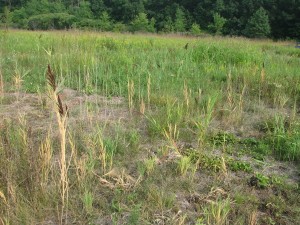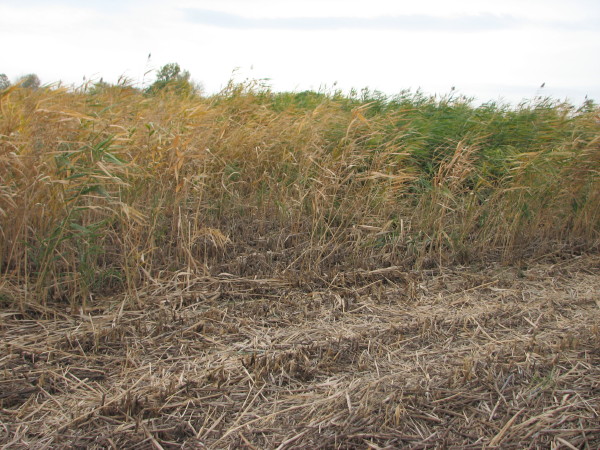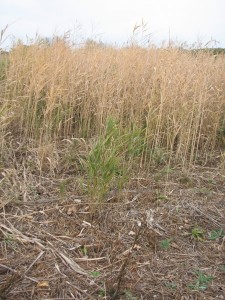May 26, 2015
Bob Williams, Phragmites.org

Returning native plants make spraying more challenging in future years. Photo credit: phragmites.org
The biggest problem I have encountered when trying to manage invasive Phragmites occurs after the first year of treatment, because the second and third years require more specific treatment. The first year is easy, because stands are so dense from years of uncontrolled growth that there are few, or no, native plants within the stand of Phragmites, so you just spray everything you can get to. In the second year you must take care to avoid any contact between the chemical spray and the newly growing native plants that are beginning to emerge from the seedbank. The invasive Phragmites may be 70 to 90 percent gone, and you now have patches of other plants to contend with, some native and some perhaps even rare or endangered. In the third year you have the same problem, but with even more native plants in the larger spaces between the remaining Phragmites patches. In the second and third years, the time involved, per acre, to do a responsible treatment can actually increase rather than decrease, because treating responsibly means treating by hand or very carefully controlled spraying. When I found this happening in my first few years of treatments, I began to realize that the first year of treatment is the most important of all. The control obtained in the first year must be as complete as possible to avoid doing damage to the desirable plants during future years’ treatments.
My solution to the problem of getting the most complete control possible in the first year is twofold. One, pre-cut in the winter prior to the first chemical treatment. This recommendation I discuss in a separate blog: Why pre-cut Phragmites in the winter before the first chemical treatment? My second recommendation is to apply multiple chemical treatments during the treatment season.
If you are going for maximum control in the first year, I suggest you spray once in mid-August, as soon as the weather allows. Then, go back ten days to two weeks later and inspect the plants. The effects of your first treatment should be showing in the form of yellowing or browning of the leaves. If not, wait a few days and inspect again. If you see the signs of damage to the plants in the area treated, you will also notice that some of plants may still be somewhat green. If you stop now with the one spraying, you will have to deal with those unaffected plants next year, and in the meantime, desirable plants will have had time to grow nearby. Go back and spray any of the invasive Phragmites that are still green, and come back ten days to two weeks later to inspect again. After the second treatment you may still have some that are green so spray the green Phragmites again. During your second and third treatments do not re-spray the Phragmites that already turned yellow or brown. My experience is that you can get up to a 98% control rate with pre-cutting, combined with three chemical treatments in the first year.

The Phragmites plants that are still green after the first treatment should be sprayed again. Photo credit: phragmites.org
The first question I am always asked is, “Is this legal?” The answer is, “Yes, it is.” You are permitted to conduct additional treatments if factors prohibit the use of the full product amount in a given area, provided that a minimum length of time is observed between treatments. Due to the dense nature and height of most stands of invasive Phragmites, the chemicals may not reach all parts of the infestation during the first treatment. While the requirement is that there must be 24 hours minimum between treatments, you really should wait ten to fourteen days to properly observe which areas did not receive the full product amount, indicated by a lack of discoloration.
The second question I am usually asked is, “Isn’t that a lot of herbicide to be putting into our environment?” The answer is “No.” I observe the limit of six to eight pints of glyphosate, per acre, per year, by mixing my spray to half the strength of what is recommended in the Michigan Guide to the Control and Management of Invasive Phragmites. My cut-strength rate exactly matches the Federal requirements on the herbicide label. In the end, I get a much better control rate the first year, actually put less chemical into the environment, and end up protecting the returning native plants from unnecessary herbicide exposure in future years.
Due to funding limitations this multi-treatment system is not usually an option for government agencies and large scale properties being treated under grants. However, I strongly suggest it whenever practical, such as for homeowners and small scale projects. In my next blog I will discuss some differences between large and small scale treatment methods and how invasive Phragmites management programs can be tailored to the size of the project and those who are doing the management work.

